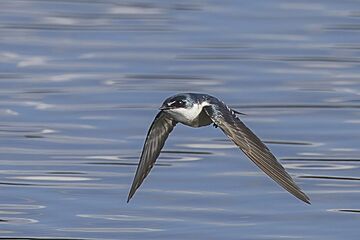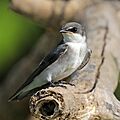Mangrove swallow facts for kids
Quick facts for kids Mangrove swallow |
|
|---|---|
 |
|
| Near Flores, Peten, Guatemala | |
| Conservation status | |
| Scientific classification | |
| Genus: |
Tachycineta
|
| Species: |
albilinea
|
 |
|
| Range of T. albilinea Resident range | |

The mangrove swallow (Tachycineta albilinea) is a small bird in the swallow family. It lives in coastal areas from Mexico through Central America to Panama. This bird has shiny blue-green feathers on its back and white feathers underneath. It also has a black tail and dark wings.
You can spot a mangrove swallow by the white line above its eye. Only two other swallows in its group have this special mark. Male and female mangrove swallows look very similar. Young birds are duller, with grey-brown backs. Their song is a soft trilling sound, and they make a sharp alarm call if there's danger.
Mangrove swallows are very protective of their nesting areas. They build their nests in holes or cracks, usually close to water and low to the ground. These birds mostly hunt for food alone when they are breeding. However, they will join groups to find food at other times. They eat insects that fly, like dragonflies and bees.
The mangrove swallow is not considered an endangered species. There are at least 500,000 of them. Their numbers are slowly going down, but not fast enough to be a big worry. We don't know much about what animals hunt them. But their nests can sometimes be taken over by termites or black flies.
Contents
About the Mangrove Swallow
The mangrove swallow was first officially described in 1863. It was named by an American bird expert, George Newbold Lawrence. Its scientific name, Tachycineta albilinea, has a cool meaning. Tachycineta comes from an old Greek word meaning "moving quickly." Albilinea comes from Latin words meaning "white line," which refers to the white stripe above its eye.
Swallows are part of a larger bird family. Scientists group them based on how they build their nests. Mangrove swallows belong to the "nest-adopters" group. This means they use natural holes or cracks for their homes. There are nine types of Tachycineta swallows. They all have shiny blue or green backs and white undersides. The mangrove swallow is closely related to other swallows with white rumps, like the Tumbes swallow.
What Does a Mangrove Swallow Look Like?
The mangrove swallow is a small bird. It is about 11 to 12 centimeters (4 to 5 inches) long. It weighs around 14 grams (half an ounce), which is about as much as two quarters. Adults have shiny blue-green feathers on their upper bodies. Their bellies, rumps, and underwing feathers are white. Their tails and flight feathers are blackish. The blue-green color can look more green when the feathers are new. It looks bluer when they are older.
Their small beaks are black. Their eyes are dark brown. Their legs and toes are dark brown to black. They have black patches around their eyes with a thin white line above them. This white line is a special feature. Only the violet-green swallow and the white-rumped swallow also have it. The tail of an adult mangrove swallow is only slightly forked.
Male and female mangrove swallows look alike. However, females have slightly longer tails and slightly shorter wings than males. Young mangrove swallows look different. They have dull grey-brown backs and whitish-grey bellies. Sometimes, their upper parts have a faint green shine.
The mangrove swallow makes a rolling "jeerrrt" sound. It also makes a "chriet" call. Its song is often described as a soft trilling sound. When it senses danger, it uses a short, sharp alarm note.
Where Do They Live?
This swallow lives in Mexico and all of Central America. This includes countries like Belize, Guatemala, Honduras, El Salvador, Nicaragua, Costa Rica, and Panama. They usually live near calm water, like rivers or lakes. They also like mangrove forests, which is how they got their name. Sometimes, they are found in areas where the ocean tide goes in and out.
In Mexico, they usually live below 600 meters (2,000 feet) in elevation. In Costa Rica, they can be found as high as 1,000 meters (3,300 feet). But they usually stay closer to sea level. They are rarely seen in high mountain areas. The mangrove swallow has also been seen in the United States, specifically in Florida. This was first recorded in 2002. These swallows live in their home areas all year round. However, they might move around a bit after breeding season.
Mangrove Swallow Behavior
Mangrove swallows love calm, open water. When they are not breeding, they often fly in small groups over rivers or lakes. They fly directly and low over the water. They use quick wingbeats and sometimes glide. Between hunting for food, they often perch (sit) near the water.
Their Homes
The mangrove swallow is a bird that likes its space. Their nests are usually at least 50 meters (160 feet) apart. Often, they are about 300 meters (1,000 feet) from each other. They build their nests in natural holes or cracks near water. This could be in a tree stump or a dead tree. They also sometimes nest in special nest boxes that people put out.
The nest is usually a few centimeters deep. It is made of grass, small stems, moss, leaves, and sticks. They line the nest with soft feathers. Nests are typically built less than 2 meters (6.5 feet) above the ground. Even though they are low, they are usually above the water level if there's a flood. They can build nests in tree holes, rock cracks, or even under bridges.
Reproduction and Life Cycle
Mangrove swallows usually have two sets of babies during their five-month breeding season. In Central America, this season is from January to July. In Mexico, it's from March to June or July. These swallows are very aggressive towards other swallows when they are breeding. They protect their nesting area strongly.
These birds usually mate with only one partner. However, sometimes a female's eggs might be fertilized by a male who is not her main partner. This happens in about 15% of nests. Males will often follow fertile females more closely to make sure their own eggs are laid.
A female mangrove swallow lays three to five white eggs. The eggs hatch in about 17 days. On average, the eggs are about 17.3 by 12.8 millimeters (0.68 by 0.50 inches) in size. They weigh about 1.6 grams (0.06 ounces). The eggs don't all hatch at the same time. About 60% of the eggs successfully hatch. Both parents feed the baby birds. The young birds stay in the nest for 23 to 27 days until they are ready to fly. Usually, only one baby bird from each nest successfully learns to fly.
What Do They Eat?
Mangrove swallows mainly eat small, flying insects. They can even catch large insects like dragonflies and bees. The insects they eat are quite big for a bird of their size. They usually hunt close to the surface of bays, lakes, and large rivers. Sometimes, they fly 30 meters (100 feet) or more above the water to find food. They often hunt in the early morning and late afternoon. When they have babies, they feed them right after sunrise and before sunset.
When they are not breeding, mangrove swallows often hunt in small groups. But when they are breeding, they hunt alone or in pairs. They usually stay within about 100 meters (330 feet) of their nest when hunting for their babies. But when they are hunting for themselves, they might go as far as 200 meters (660 feet) from their nest. They usually stay within their own territory to find food.
Dangers and Health
We don't know much about what animals hunt mangrove swallows. However, their nests can sometimes be destroyed by termites or black flies. The black flies mostly affect nests in artificial nest boxes. These flies are often found near streams and their numbers depend on the weather. Mangrove swallows can also host a type of nasal mite called Sternostoma hirundinis.
Conservation Status
As of 2016, the mangrove swallow is listed as a species of "least concern" by the International Union for Conservation of Nature (IUCN). This means they are not currently at high risk of extinction. There is some evidence that their population is shrinking. This might be because their homes are being destroyed or because of the use of pesticides.
However, the mangrove swallow has a very large population, estimated to be over 500,000 birds. They also live across a huge area, about 3.17 million square kilometers (1.2 million square miles). Even though their numbers are going down, it's not happening fast enough for them to be considered a vulnerable species.
Images for kids











